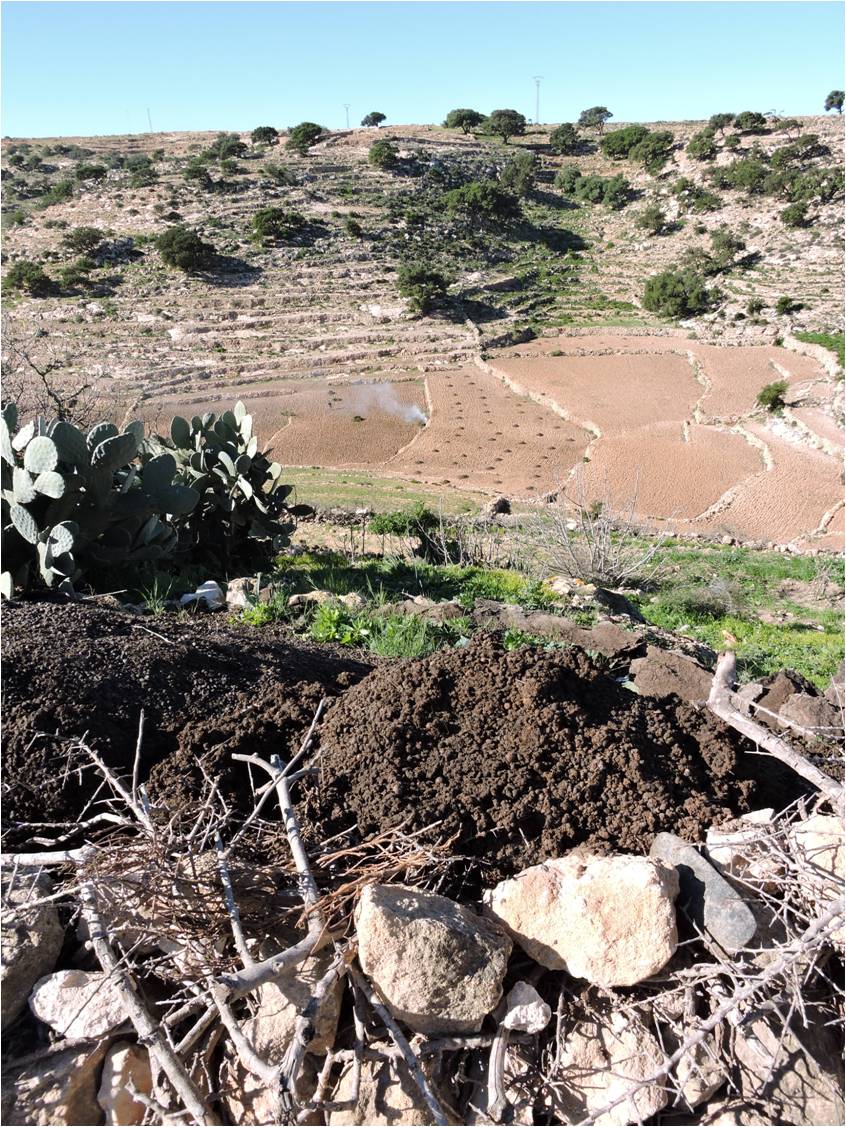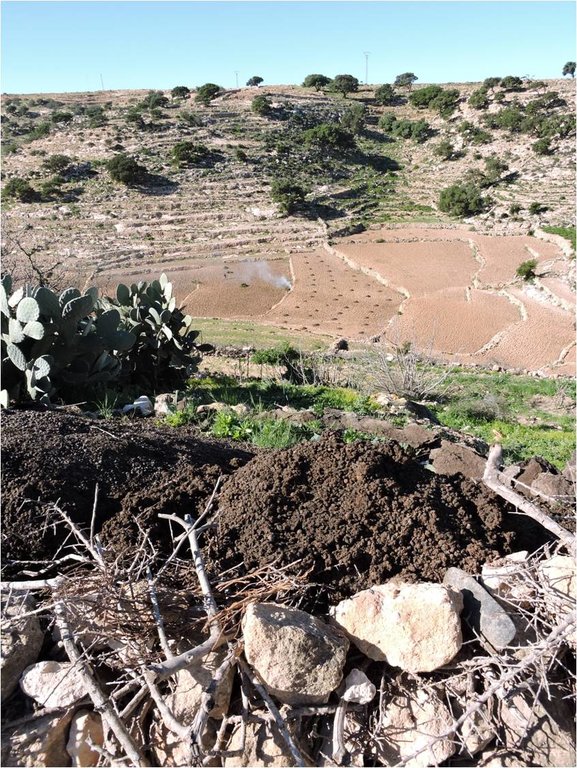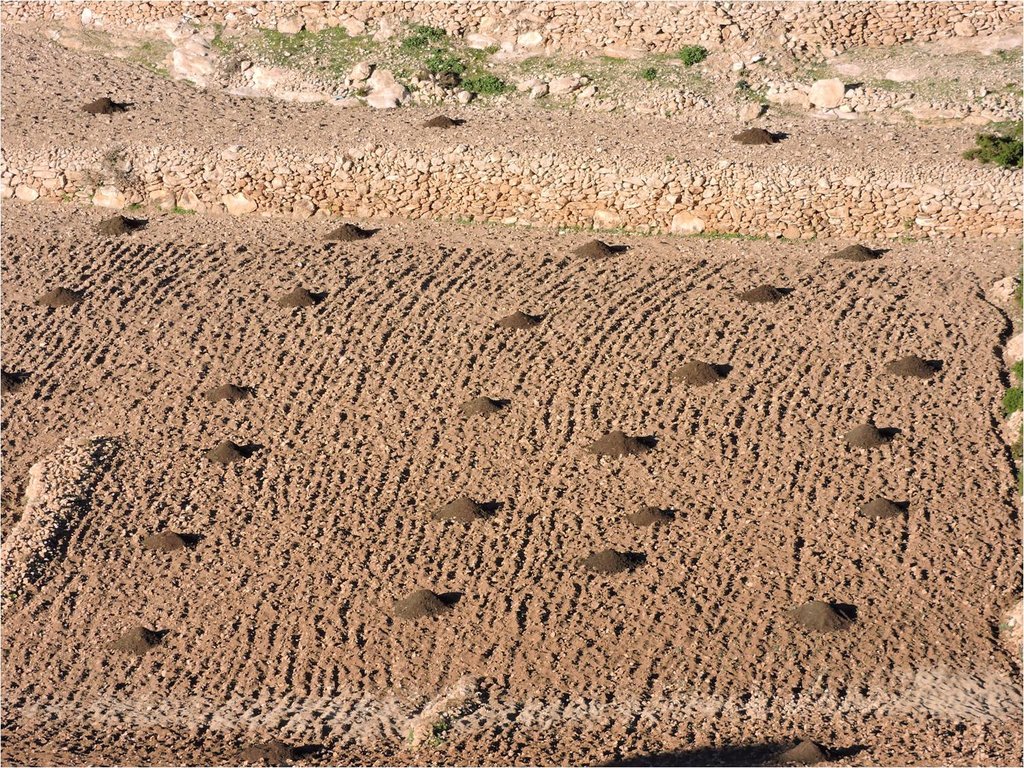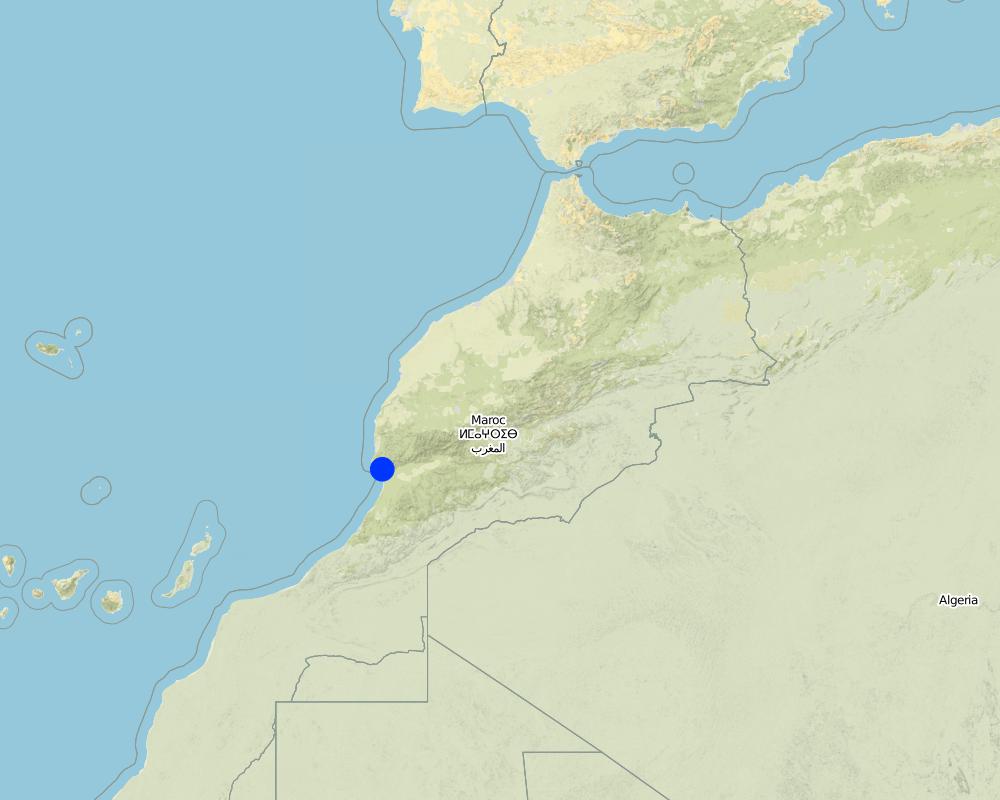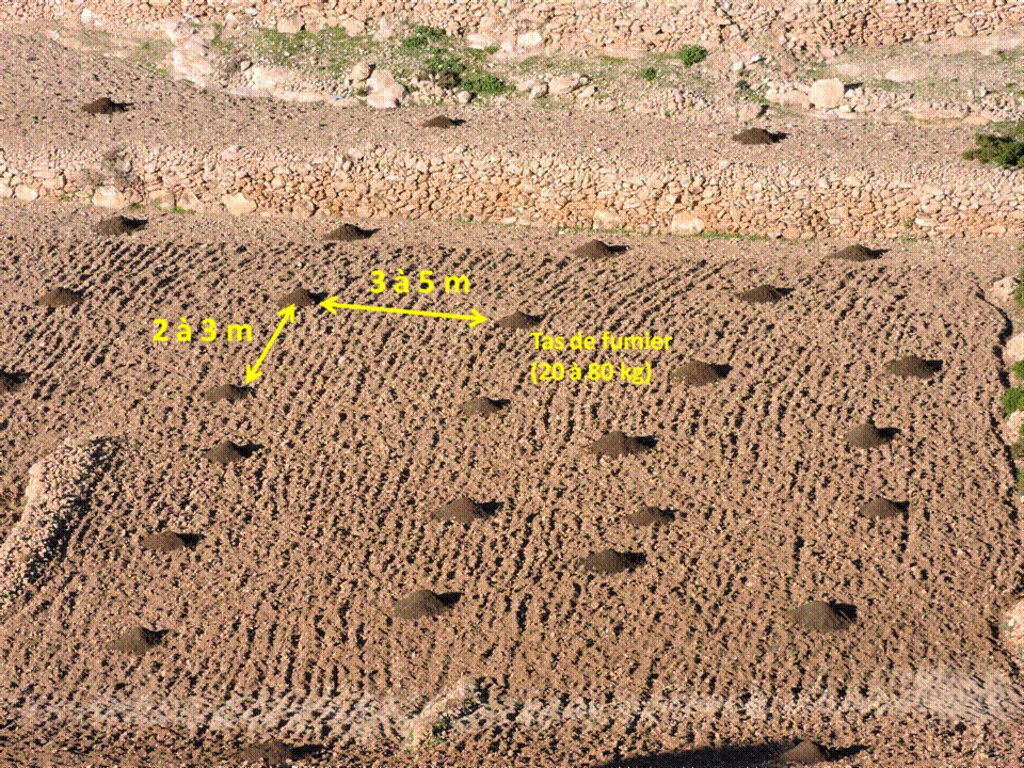Fumier [Morocco]
- Creation:
- Update:
- Compiler: Mohamed Sabir
- Editor: –
- Reviewers: Donia Mühlematter, Rima Mekdaschi Studer, Nicole Harari, Alexandra Gavilano
Ghbar
technologies_3207 - Morocco
View sections
Expand all Collapse all1. General information
1.2 Contact details of resource persons and institutions involved in the assessment and documentation of the Technology
land user:
Balqqassam Mohammad
Morocco
Name of project which facilitated the documentation/ evaluation of the Technology (if relevant)
Decision Support for Mainstreaming and Scaling out Sustainable Land Management (GEF-FAO / DS-SLM)Name of the institution(s) which facilitated the documentation/ evaluation of the Technology (if relevant)
Royaume du Maroc, Haut Commissariat aux Eaux et Forêts et à la Lutte Contre la Désertification (Royaume du Maroc) - Morocco1.3 Conditions regarding the use of data documented through WOCAT
The compiler and key resource person(s) accept the conditions regarding the use of data documented through WOCAT:
Yes
1.4 Declaration on sustainability of the described Technology
Is the Technology described here problematic with regard to land degradation, so that it cannot be declared a sustainable land management technology?
No
2. Description of the SLM Technology
2.1 Short description of the Technology
Definition of the Technology:
Le fumier est un compost traditionnel produit par l'élevage de l'exploitation et qui sert pour une fertilisation organique des sols cultivés.
2.2 Detailed description of the Technology
Description:
Le fumier est un mélange des excréments, urines et des restes d'aliments des animaux avec la litière des écuries et les déchets de la maison (cuisine: légumes, cendres, etc.). Il est accumulé progressivement sous forme de tas dans un endroit loin de la case (odeur). Au début de la période de préparation des terres pour la culture (fin automne), le fumier et transporté à dos d'anes ou mulets et déposé en petits tas sur les parcelles destinées au labour. Le jour du semis de la céréale (grain ou fourrage), le fumier est étalé sur la surface puis enfoui par la charue souvent à traction animale.
La quantité produite et apportée aux parcelles est très variable et dépend de la taille du cheptel. Les paysans apportent au maximum 10 tonnes/ha/an, ce qui reste faible par rapport aux besoinx de récupération de la fertilite des terres. En outre, le fumier produit traditionnellement est de mauvaise qualité.
Son stockage à l'air libre ne permet pas une bonne fabrication. Le soleil le dessèche et la pluie le lessive. Il est très pauvre en N, P et K.
L'apport de fumier de bonne qualité permet de récupérer une grande partie de la matière organique et de la fertilité chimique des sols continuellement cultivés. Son incorporation permet une bonne structuration des sols en surface et donc une amélioration de leur capacité d'infiltration et de rétention d'eau. Les sols fumés produisent plus que les sols qui ne le sont pas. Le rendement en grains et paille peut être triplé par un apport de 20 t/ha/an de fumier sur sols sablo-limoneux.
Les paysans fournissent beaucoup d'efforts pour produire et utiliser le fumier sur les parcelles à fort potentiel de production parcequ'ils sont convaincus qu'il améliore les rendements.
2.3 Photos of the Technology
2.5 Country/ region/ locations where the Technology has been applied and which are covered by this assessment
Country:
Morocco
Region/ State/ Province:
Province d'Agadir
Specify the spread of the Technology:
- evenly spread over an area
If precise area is not known, indicate approximate area covered:
- 100-1,000 km2
Map
×2.6 Date of implementation
If precise year is not known, indicate approximate date:
- more than 50 years ago (traditional)
2.7 Introduction of the Technology
Specify how the Technology was introduced:
- as part of a traditional system (> 50 years)
3. Classification of the SLM Technology
3.1 Main purpose(s) of the Technology
- improve production
- reduce, prevent, restore land degradation
- create beneficial economic impact
3.2 Current land use type(s) where the Technology is applied
Land use mixed within the same land unit:
Yes
Specify mixed land use (crops/ grazing/ trees):
- Agro-silvopastoralism

Cropland
- Annual cropping
- Tree and shrub cropping
Annual cropping - Specify crops:
- fodder crops - other
- cereals - other
Tree and shrub cropping - Specify crops:
- olive
Number of growing seasons per year:
- 1

Grazing land
Comments:
Principales cultures (vivrières et commerciales): Céréales, fourrages, oliviers et arganiers.
3.4 Water supply
Water supply for the land on which the Technology is applied:
- rainfed
3.5 SLM group to which the Technology belongs
- integrated soil fertility management
3.6 SLM measures comprising the Technology

agronomic measures
- A2: Organic matter/ soil fertility
3.7 Main types of land degradation addressed by the Technology

chemical soil deterioration
- Cn: fertility decline and reduced organic matter content (not caused by erosion)
3.8 Prevention, reduction, or restoration of land degradation
Specify the goal of the Technology with regard to land degradation:
- restore/ rehabilitate severely degraded land
4. Technical specifications, implementation activities, inputs, and costs
4.1 Technical drawing of the Technology
Technical specifications (related to technical drawing):
Le fumier a une influence favorable sur les rendements. Sa restitution progressive des nutriments, leur effet positif sur le pH et les autres caractéristiques physiques du sol sont bien connues des paysans.
Le fumier transporté à dos d’animal (mulets, ânes) est déposé sous forme de petits tas sur les parcelles et terrasses souvent au début de la période des labours (novembre – janvier) (1 à 20 t/ha).
Avant le travail du sol (labour à l’araire ou cover crop), il est étalé sur la surface puis mélangé au sol par le labour. Comme le système d'élevage est extensif, avec une complémentation, le fumier produit est mélangé avec des déchets organiques frais, nécessitant alors toute une technique de compostage que les paysans ne maîtrisent pas encore, ce qui réduit la qualité du fumier produit. Presque tous les paysans ajoutent les résidus de la maison (balayures, épluchures, vêtements) sur le tas de fumier.
Author:
Sabir Mohamed
Date:
26/01/2017
4.2 General information regarding the calculation of inputs and costs
Specify how costs and inputs were calculated:
- per Technology unit
Specify dimensions of unit (if relevant):
1 tone
other/ national currency (specify):
Dirham marocain MAD
If relevant, indicate exchange rate from USD to local currency (e.g. 1 USD = 79.9 Brazilian Real): 1 USD =:
9.461
Indicate average wage cost of hired labour per day:
65 MAD
4.3 Establishment activities
| Activity | Timing (season) | |
|---|---|---|
| 1. | Elevage d'un troupeau (ovins, caprins, bovins): en élevage extensif ou en stabulation. |
4.4 Costs and inputs needed for establishment
| Specify input | Unit | Quantity | Costs per Unit | Total costs per input | % of costs borne by land users | |
|---|---|---|---|---|---|---|
| Labour | Ouvrier | jour | 25.0 | 65.0 | 1625.0 | 100.0 |
| Equipment | Brouette | Unité | 1.0 | 750.0 | 750.0 | 100.0 |
| Equipment | Pelle | Unité | 1.0 | 100.0 | 100.0 | 100.0 |
| Plant material | Alimentation (fourrage) | Kg | 1900.0 | 4.0 | 7600.0 | 100.0 |
| Construction material | Cuve construite en dur | Unité | 1.0 | 2000.0 | 2000.0 | 100.0 |
| Other | Vache (qui produit 7t/an de fumier) | Unité | 1.0 | 8000.0 | 8000.0 | 100.0 |
| Total costs for establishment of the Technology | 20075.0 | |||||
| Total costs for establishment of the Technology in USD | 2121.87 | |||||
4.7 Most important factors affecting the costs
Describe the most determinate factors affecting the costs:
Alimentation du cheptel.
5. Natural and human environment
5.1 Climate
Annual rainfall
- < 250 mm
- 251-500 mm
- 501-750 mm
- 751-1,000 mm
- 1,001-1,500 mm
- 1,501-2,000 mm
- 2,001-3,000 mm
- 3,001-4,000 mm
- > 4,000 mm
Agro-climatic zone
- semi-arid
- arid
5.2 Topography
Slopes on average:
- flat (0-2%)
- gentle (3-5%)
- moderate (6-10%)
- rolling (11-15%)
- hilly (16-30%)
- steep (31-60%)
- very steep (>60%)
Landforms:
- plateau/plains
- ridges
- mountain slopes
- hill slopes
- footslopes
- valley floors
Altitudinal zone:
- 0-100 m a.s.l.
- 101-500 m a.s.l.
- 501-1,000 m a.s.l.
- 1,001-1,500 m a.s.l.
- 1,501-2,000 m a.s.l.
- 2,001-2,500 m a.s.l.
- 2,501-3,000 m a.s.l.
- 3,001-4,000 m a.s.l.
- > 4,000 m a.s.l.
Indicate if the Technology is specifically applied in:
- not relevant
5.3 Soils
Soil depth on average:
- very shallow (0-20 cm)
- shallow (21-50 cm)
- moderately deep (51-80 cm)
- deep (81-120 cm)
- very deep (> 120 cm)
Soil texture (topsoil):
- medium (loamy, silty)
Soil texture (> 20 cm below surface):
- coarse/ light (sandy)
- medium (loamy, silty)
Topsoil organic matter:
- low (<1%)
5.4 Water availability and quality
Ground water table:
> 50 m
Availability of surface water:
poor/ none
Water quality (untreated):
poor drinking water (treatment required)
5.5 Biodiversity
Species diversity:
- high
Habitat diversity:
- medium
5.6 Characteristics of land users applying the Technology
Sedentary or nomadic:
- Sedentary
Market orientation of production system:
- subsistence (self-supply)
Off-farm income:
- 10-50% of all income
Relative level of wealth:
- very poor
- poor
Individuals or groups:
- individual/ household
Level of mechanization:
- manual work
- animal traction
Gender:
- men
Age of land users:
- youth
- middle-aged
5.7 Average area of land used by land users applying the Technology
- < 0.5 ha
- 0.5-1 ha
- 1-2 ha
- 2-5 ha
- 5-15 ha
- 15-50 ha
- 50-100 ha
- 100-500 ha
- 500-1,000 ha
- 1,000-10,000 ha
- > 10,000 ha
Is this considered small-, medium- or large-scale (referring to local context)?
- medium-scale
5.8 Land ownership, land use rights, and water use rights
Land ownership:
- individual, not titled
- individual, titled
Land use rights:
- open access (unorganized)
5.9 Access to services and infrastructure
health:
- poor
- moderate
- good
education:
- poor
- moderate
- good
technical assistance:
- poor
- moderate
- good
employment (e.g. off-farm):
- poor
- moderate
- good
markets:
- poor
- moderate
- good
energy:
- poor
- moderate
- good
roads and transport:
- poor
- moderate
- good
drinking water and sanitation:
- poor
- moderate
- good
financial services:
- poor
- moderate
- good
6. Impacts and concluding statements
6.1 On-site impacts the Technology has shown
Socio-economic impacts
Production
crop production
fodder production
risk of production failure
Income and costs
farm income
workload
Socio-cultural impacts
food security/ self-sufficiency
SLM/ land degradation knowledge
Ecological impacts
Soil
soil moisture
soil loss
soil crusting/ sealing
nutrient cycling/ recharge
soil organic matter/ below ground C
6.4 Cost-benefit analysis
How do the benefits compare with the establishment costs (from land users’ perspective)?
Short-term returns:
positive
Long-term returns:
positive
6.5 Adoption of the Technology
- > 50%
Of all those who have adopted the Technology, how many did so spontaneously, i.e. without receiving any material incentives/ payments?
- 91-100%
6.6 Adaptation
Has the Technology been modified recently to adapt to changing conditions?
No
6.7 Strengths/ advantages/ opportunities of the Technology
| Strengths/ advantages/ opportunities in the land user’s view |
|---|
| Améliore la fertilité des sols et donc de leur productivité. |
| Strengths/ advantages/ opportunities in the compiler’s or other key resource person’s view |
|---|
| Améliore la fertilité des sols et donc de leur productivité. |
6.8 Weaknesses/ disadvantages/ risks of the Technology and ways of overcoming them
| Weaknesses/ disadvantages/ risks in the land user’s view | How can they be overcome? |
|---|---|
| Production faible en fumier. | Avec une bonne alimentation du cheptel et plus de litière dans les écuries. |
| Qualité médiocre du fumier. |
Améliorer le stockage du fumier à l'abri du soleil (à l'ombre) et de la pluie. Humectation régulière pour accentuer la fermentation Mélange des déchets de la cuisine (à trier) et des résidus de cultures (biomasse végétatles produite sur l'exploitation ou litière). |
| Weaknesses/ disadvantages/ risks in the compiler’s or other key resource person’s view | How can they be overcome? |
|---|---|
| Production faible en fumier. | Avec une bonne alimentation du cheptel et plus de litière dans les écuries. |
| Qualité médiocre du fumier. |
Améliorer le stockage du fumier à l'abri du soleil (à l'ombre) et de la pluie. Humectation régulière pour accentuer la fermentation. Mélange des déchets de la cuisine (à trier) et des résidus de cultures (biomasse végétatles produite sur l'exploitation ou litière). |
7. References and links
7.1 Methods/ sources of information
- field visits, field surveys
Plusieurs visites de terrain et plusieurs rencontres avec les paysans lors du LADA Local.
- interviews with land users
Plusieurs personnes rencontrées.
- interviews with SLM specialists/ experts
Plusieurs personnes rencontrées.
- compilation from reports and other existing documentation
When were the data compiled (in the field)?
24/01/2017
7.2 References to available publications
Title, author, year, ISBN:
Éric Roose, Mohamed Sabir, Abdellah Laouina. 2010. Gestion durable de l'eau et des sols au Maroc. Valorisation des techniques traditionnelles méditerranéennes. IRD Éditions INSTITUT DE RECHERCHE POUR LE DÉVELOPPEMENT Marseille, 2010
Available from where? Costs?
http://horizon.documentation.ird.fr/exl-doc/pleins_textes/divers12-09/010054911.pdf
Title, author, year, ISBN:
SABIR M. et ROOSE E. Restauration des sols cultivés mais dégradation des parcours par l'élevage au Maroc. In Eric ROOSE. Editeur scientifique . Restauration de la productivité des sols tropicaux et méditerranéens Contribution à l'agroécologie. INSTITUT DE RECHERCHE POUR LE DEVELOPPEMENT, MONTPELLIER, JUILLET 2015
Available from where? Costs?
http://horizon.documentation.ird.fr/exl-doc/pleins_textes/divers16-05/010064961.pdf
7.3 Links to relevant online information
Title/ description:
SABIR M. et ROOSE E. Restauration des sols cultivés mais dégradation des parcours par l'élevage au Maroc. In Eric ROOSE. Editeur scientifique . Restauration de la productivité des sols tropicaux et méditerranéens Contribution à l'agroécologie. INSTITUT DE RECHERCHE POUR LE DEVELOPPEMENT, MONTPELLIER, JUILLET 2015
URL:
http://horizon.documentation.ird.fr/exl-doc/pleins_textes/divers16-05/010064961.pdf
Links and modules
Expand all Collapse allLinks
No links
Modules
No modules


